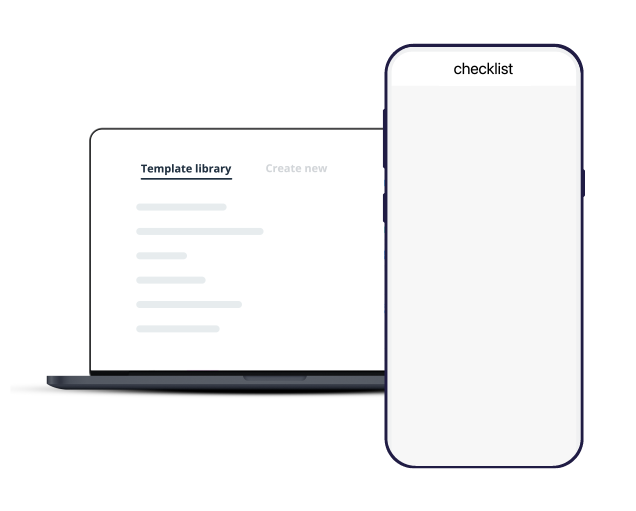Use our free retail store manager daily checklist to efficiently open your retail store for the day.
Retail Store Opening Template

Make work flow with Connecteam’s digital forms & checklists
- Easily create digital forms and checklists for any task your team needs to complete on the job
- Boost accountability by having employees add a signature, image, or location stamp
- Save time by choosing from a variety of ready-made templates
- Instantly receive your team’s submissions and share reports within your organization
- Use AI to convert PDFs, Excel files, or images into digital forms in seconds—no manual work needed

Retail Store Opening Template
Each day, use our retail store manager daily checklist when going about the task of confirming retail opening tasks – such as, checking security, initial preparation, assigning daily duties, and more. You need to make sure the store and your employees are 100% ready before you open the doors to customers.
You already know that opening your store is the most important part of the day because it sets your store up to earn money. So even if a task seems obvious, do you have enough time to get through the retail store manager daily checklist before the first customer shows up. Additionally, you want standardization between all the branches and its managers so that each branch opens the store the same way.
Our retail store manager daily checklist sets you up for success from the minute you clock in and start the day.
Retail Store Manager Daily Checklist Template
Initial Preparation
-
Get to the store early.
You need the store prepared and ready for business so you have to show up early enough to get things ready. Try to arrive at least 15 minutes, or even 30, to ensure you have a smooth day ahead of you.
-
Clock in.
Clock in using our Connecteam time tracking app when you arrive at the store, your GPS location will be tagged as soon as you clock in.
-
Turn on the lights.
When you’re inside the store, turn on the lights so that you are able to complete the rest of your tasks without a hitch. Not only will you be able to see what you’re doing but once the “open” sign is up, customers will also be able to navigate their way through the store.
-
Turn off the alarm.
Our store is equipped with a security alarm and you need to turn it off to ensure it doesn’t go off by mistake. You have 30 seconds to turn off the alarm before the police are alerted and are dispatched to your location.
Prepping the store.
-
Walk the floor.
Make sure to walk the floor of the store so you can be sure everything is ready to go. Check for spillage (if there is one, put up the “wet floor” sign and tend to it later), remove products from the floor, and so on.
-
Prepare tags.
All tags on racks should be clear and correct. Review the following to ensure the correct tag is in place, especially if stock was switched:
- Price tags
- Sales prices
- Promotion tags
- Size tags.
Customers don’t want the wrong price tag or size tag when looking to purchase an item. So to avoid confusion, make sure the right tag is in place.
-
Check the cash register.
The cash registers needs to be prepared with sufficient funds. The following notes and coins should be in the register, along with the quantity, if there is an error, contact your manager straight away:
- Bills:
- One dollar bills – 20
- Five dollar bills – 20
- Ten dollar bills – 20
- Twenty dollar bills – 20
- Large bills ($50 or $100) – 10
- Coins:
- Pennies – 100
- Dimes – 100
- Nickels – 100
- Quarters – 50
When you notice you are short on certain bills or notes, contact your direct manager to alert them to the situation so they can bring in more cash on site.
-
All electronic systems should be on.
To ensure a comfortable environment for customers and for you to do your job efficiently, the following need to be switched on:
- Computers – for stock checking, inventory, emails, etc.
- Music system.
- TV screens.
- Working displays.
-
Turn the air conditioning or heat on.
Depending on the season, make sure to turn on the correct cooling or heating system so you and our customers can enjoy a comfortable temperature while in the store.
-
Prepare the outside displays.
Organize the outside displays when needed, such as signs, and remove any clutter or litter so customers are not exposed to a mess before even entering the store.
Delegate tasks.
-
Assign duties.
A crucial part of the retail store manager daily checklist is making sure your employees know what to do while on shift. Assign the following accordingly:
-
- Cleaning: cleaning the floor, windows, restroom and changing rooms.
- Restocking: control stock levels, restock shop shelves, etc.
- Merchandising: adding correct sales signs, effective layout displayed, etc.
-
Prepare breaks.
Your employees need to know when they can take scheduled breaks and their lunch hour so that everything runs smoothly.
A final check.
-
Quick meeting.
Hold a quick meeting to let your employees know what their goals are for the day, what they need to do and when. Have your employees do one final check of the store to make sure all preparation is ready to go.
-
Open the store.
Unlock the doors and flip the sign to “open” so that customers know we’re open for business.
Related Templates:
Follow our free template to Close Your Retail Store for the night
Download our free Retail Safety Checklist to ensure safety at your store
Watch the video below to see it in action:

Ready to boost your efficiency with our pre-made templates?